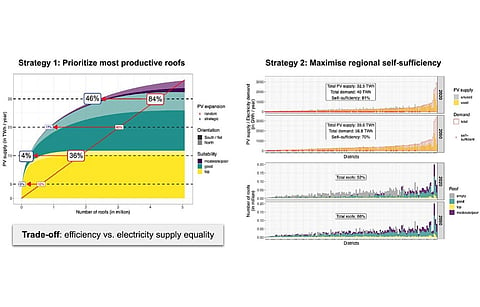

Swiss university Ecole Polytechnique Fédérale de Lausanne (EPFL) has conducted research into figuring the quickest way for Switzerland to achieve its Energy Strategy 2050 target of generating 45 TWh electricity from renewables.
The answer is equipping millions of rooftops with solar panels. Research carried out by EPFL's PhD student Alina Walch claims 5 million rooftops, representing over half of the national total, are suitable for generating power. Equipping them with solar systems could make over 2/3rd of Swiss towns and cities become energy self-sufficient, it adds.
This self-sufficiency is important to achieve as the world faces increasing geopolitical uncertainty and other global pressures. It entails generating electricity closer to where it is needed.
Walch put together Big Data with Machine Learning along with Dr. Martin Rüdisüli, an expert in energy-system modeling at the Swiss Federal Laboratories for Materials Science and Technology (Empa) to analyze the country's solar rooftop potential.
Factoring in north-facing rooftops with a pitch angle of less than 20° along with south-facing rooftops shot up the solar power potential by 25%.
Convinced of this, the duo recommends prioritizing large, flat roofs such as those on industrial and agricultural buildings as offering the highest solar potential. These have fewer skylights, chimney stacks and other superstructures, and are located far away from built-up areas so these are not seen prominently.
Covering just 4% of such rooftops with solar panels can help generate 15 TWh annually, according to the researchers. Adding another 2.5 million rooftops would be 'a quick and easy way to achieve the 2050 target of 45 TWh.'
The other strategy to achieve the national targets as recommended by the researchers is to make this energy generation more regionally balanced, especially with regard to the urban areas. Walch said the team ran simulations to understand how much power each district would need to generate to become self-sufficient.
She found, "Rural towns could easily cover their power needs – without even having to tap into their full potential. But for cities, self-sufficiency is a near-impossible goal, so there's an imbalance that we can't correct for."
According to Walch, solar panels need to be deployed on 4 million rooftops to achieve the federal government's targets to better meet power demand on a regional level.
"The ideal approach is to start by fitting solar panels onto the biggest roofs in each city until the targets are met. After this point, once a city's energy needs are covered by renewables, limits should be placed on any new installations," she recommends.
The detailed paper has been published in the Journal of Physics under the title A critical comparison of methods to estimate solar rooftop photovoltaic potential in Switzerland.
In a previous study headed by Walch, the EPFL and Oxford University had stated that Switzerland can meet more than 40% of its electricity demand with rooftop solar (see Rooftop PV Could Cover Over 40% Of Swiss Electricity Demand).
.png?w=50&fm=png)